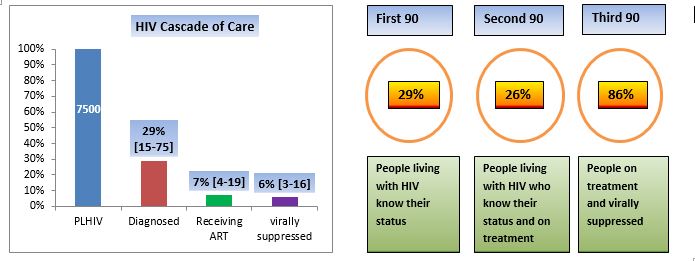Sociodemographic data
- Population: 33.4 million; percentage of urban population: 27%
- Births per 1000 population: 37
- Deaths per 1000 population: 8
- Infant mortality rate: 68
- Human development index rank: 171 (low)
- Gross national income (per capita): US$ 1990 (low income)
HIV care cascade and progress towards 90-90-90

Epidemiological data (2016)
HIV estimates and case notification
|
|
Estimated |
Reported |
|
HIV prevalence in general population |
0.1 |
NA |
|
People Living with HIV (PLHIV) |
7500 [3900 – 19,000] |
2131 |
|
New infections |
204 |
|
|
AIDS related deaths |
26 |
|
|
|
|
|
HIV in specific populations
|
|
Survey data |
|
Size estimate |
Routine testing and VCT data |
|
|
Key populations |
Prevalence |
|
|
No tested |
HIV+ cases (%) |
|
Sex workers (SW) |
0.2 (2012) |
|
12500 |
131 |
0 |
|
Men having sex with men (MSM) |
0.4 (2012) |
|
10700 |
4123 |
21 (0.5%) |
|
People who inject drugs (PWIDs) |
4.4 (2012) |
|
40900 |
13581 |
35 (0.2%) |
|
Prisoners |
NA |
|
28000 |
9997 |
2 (.02%) |
|
Populations in health settings |
|
|
|
|
|
|
TB patients |
|
|
|
3028 |
12 (0.4%) |
|
Pregnant women |
|
|
|
2167 |
4 (0.2%) |
|
Blood Donors |
|
|
|
128,167 |
0 (0%) |
|
Clients of testing services |
|
|
|
26789 |
134 (0.5%) |
Response
Policy implementation
|
|
|
|
Policy CD4 threshold adults and adolescents |
Treat all |
|
Recommended initiation threshold children |
Treat all |
|
Policy of lifelong ART to pregnant & breastfeeding women |
Option B+ |
|
Implementation of lifelong ART to pregnant & breastfeeding women |
Done in a small number of MCH sites |
|
Implementation of national policy on viral load monitoring |
Not implemented |
HIV testing coverage in key populations *
 Antiretroviral therapy and PMTCT coverage
Antiretroviral therapy and PMTCT coverage
References
1 http://www.prb.org/pdf16/prb-wpds2016-web-2016.pdf; (2) WHO.EMRO Regional Surveillance Data; (3) WHO/UNAIDS data spectrum 2016; (4) Global AIDS Monitoring (GAM) 2016.*These are approximate estimations based on the latest available data for number of people tested and size estimates.






